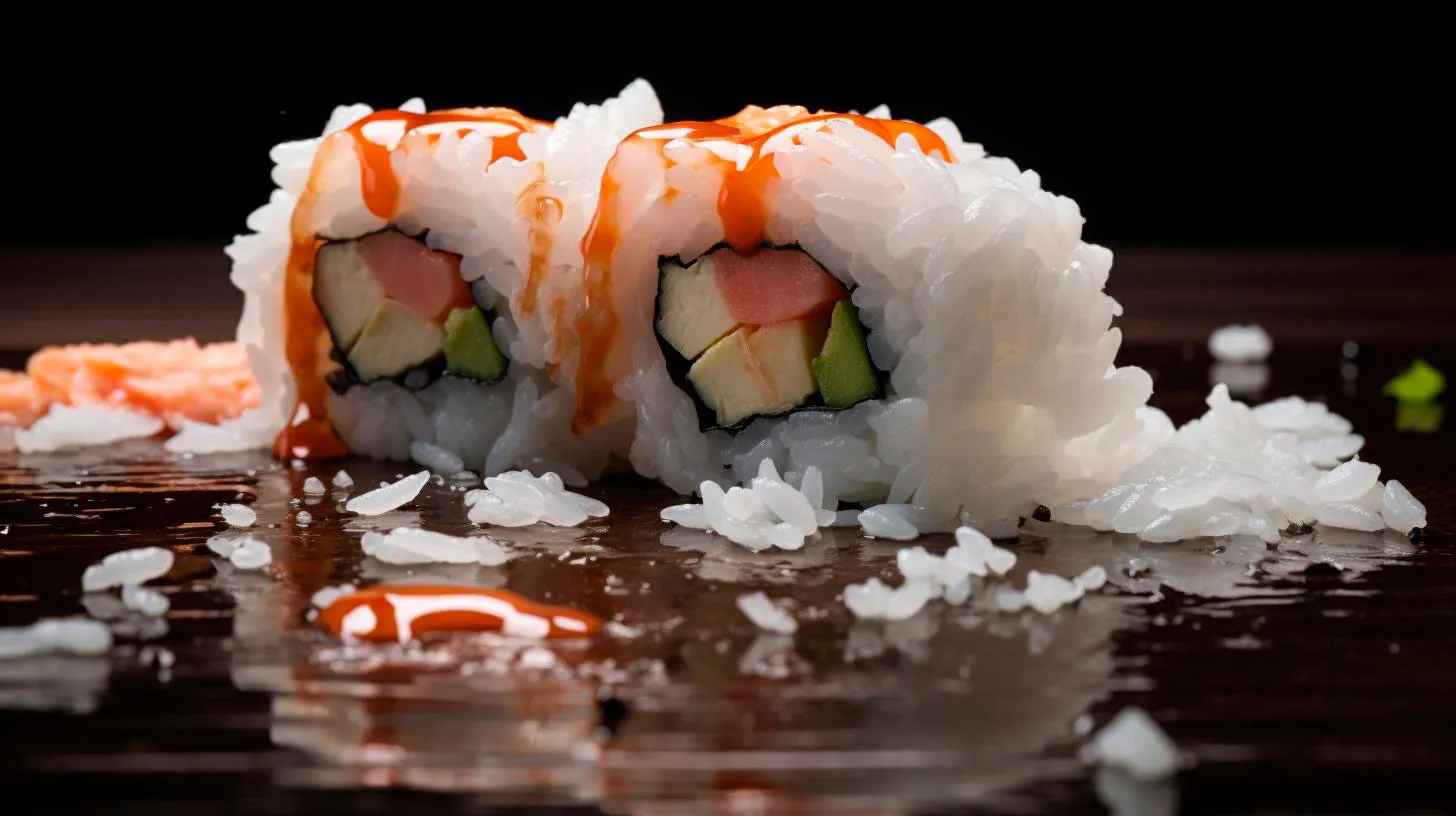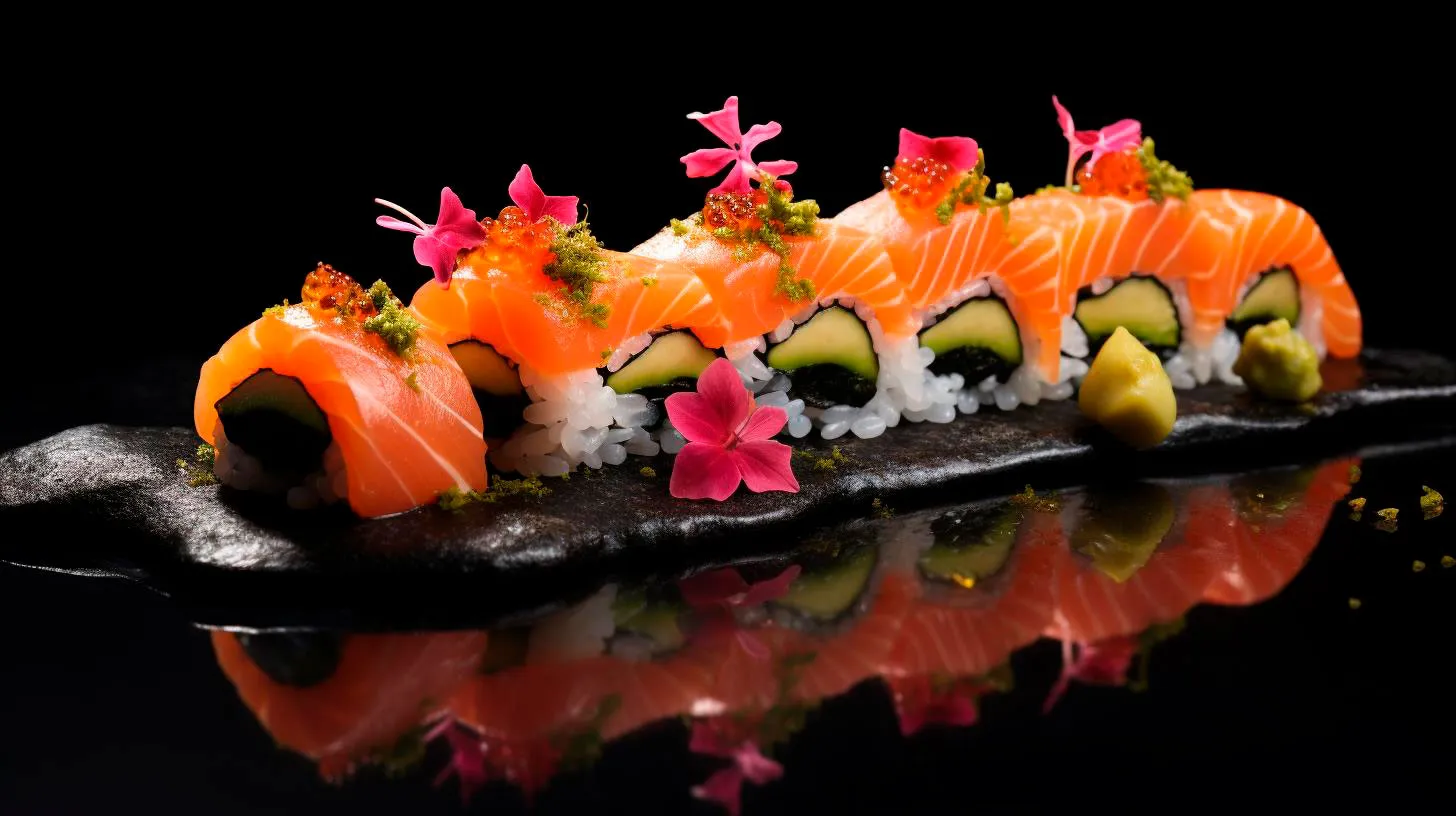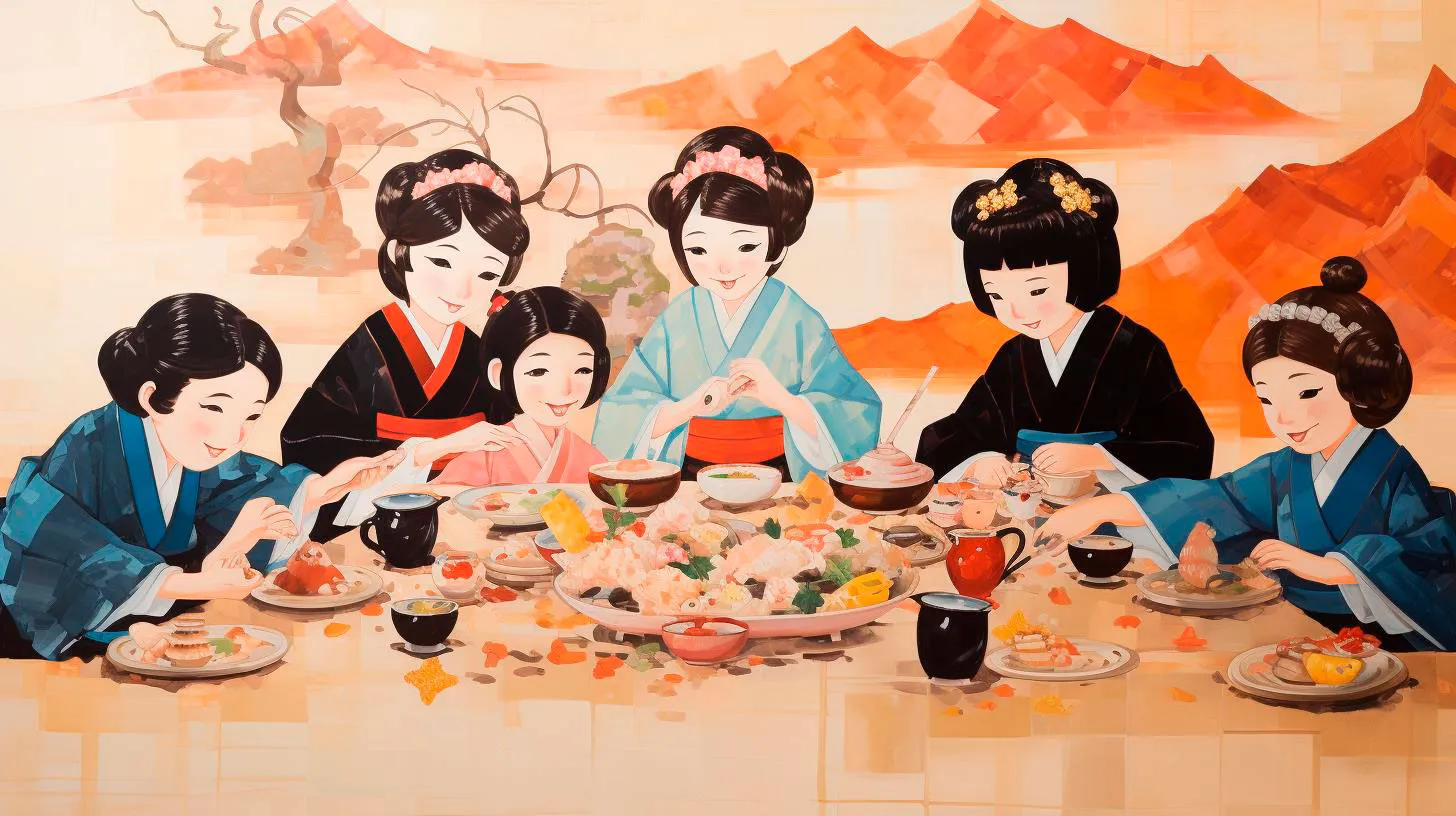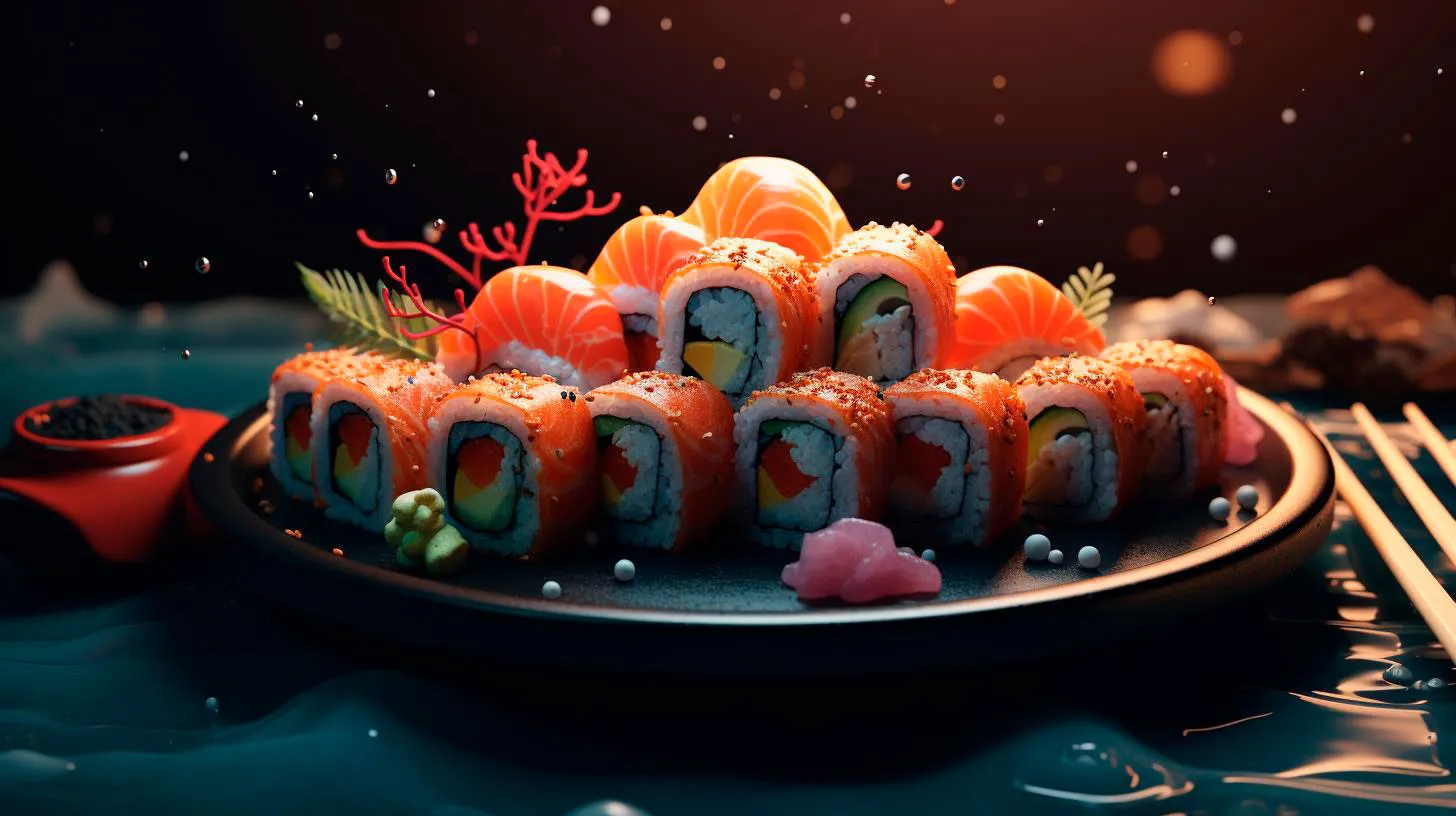The Art of Sushi: A Visual Feast of Regional Delicacies
Sushi: A Culinary Delight
Sushi is a Japanese dish that combines bite-sized portions of sticky rice, commonly seasoned with vinegar, with a variety of ingredients. These ingredients can include raw or cooked fish, seafood, vegetables, and sometimes even fruits. Typically, sushi is garnished with wasabi, soy sauce, and pickled ginger to enhance its flavors.
While the term “sushi” is often used to refer to the variety of rolled sushi known as maki, there are several other traditional styles worth exploring:
1. Nigiri
Nigiri sushi is perhaps the most well-known style of sushi. It consists of a hand-pressed mound of sushi rice topped with a slice of fresh fish or seafood. The simplicity of this style allows the flavors of the fish to shine, creating a harmonious bite.
2. Sashimi
Sashimi is the purest expression of sushi. It consists of thinly sliced, fresh fish served without any rice. The focus is solely on the quality and freshness of the fish, making it a favorite among seafood enthusiasts.
Regional Variations: A Visual Feast
Japan is a country of diverse regions, each with its own sushi traditions and styles. Let’s explore some of the regional variations that contribute to the kaleidoscope of flavors and visuals in the world of sushi:
1. Edomae-zushi (Tokyo Style)
Originating in Tokyo, Edomae-zushi is a style that focuses on the use of fresh, local ingredients. The sushi is typically prepared with fish sourced from Tokyo Bay, such as maguro (tuna) or hamachi (yellowtail). The simplicity of this style allows the natural flavors of the fish to shine through.
2. Osaka Style
Osaka-style sushi, also known as battera-zushi, is characterized by its rectangular shape. Pressed into a wooden mold, the sushi rice is layered with toppings such as mackerel or eel, creating a visually striking presentation.
3. Chirashi-zushi (Scattered Sushi)
Chirashi-zushi is a colorful assortment of ingredients scattered over a bed of sushi rice. This style allows for great creativity, as chefs can include a variety of toppings such as sashimi, tamagoyaki (rolled omelet), and colorful vegetables. Every bite is a burst of flavors and textures.
The Advantages of Sushi
Sushi is not only a visual delight but also offers numerous advantages that make it a popular choice among food lovers:
- Sushi is a healthy option: With its emphasis on fresh seafood and vegetables, sushi is a nutritious choice. It provides an abundance of omega-3 fatty acids, essential vitamins, and minerals.
- Sushi is versatile: With a range of fillings and toppings, sushi can cater to various dietary preferences. Whether you are a seafood lover or a vegetarian, there is a sushi roll for everyone.
- Sushi is low in calories: Compared to many other cuisines, sushi is relatively low in calories, making it a great option for those watching their weight.
- Sushi is a work of art: The intricate presentation of sushi highlights the skill and creativity of the chef. The visual appeal of a beautifully arranged sushi platter adds to the overall dining experience.
Key Takeaways
The world of sushi is a journey of flavors and captivating visuals. Here are the key takeaways from our exploration of sushi:
- Sushi is an art form that combines flavors, colors, and textures to create a visually stunning and delicious meal.
- Regional variations in sushi offer unique flavors and styles, showcasing the diversity within the culinary world.
- Sushi is not only a treat for the taste buds but also a healthy and low-calorie option.
- The artistry of sushi lies not only in the taste but also in the meticulous presentation, making it a feast for the eyes.
So, the next time you indulge in a plate of sushi, savor each bite and appreciate the artistry that goes into creating this delightful dish. Whether you opt for the simplicity of nigiri or the vibrant colors of chirashi-zushi, sushi is truly a feast for the senses.
Regional Sushi Delights: A Visual Journey through Japan’s Gastronomic Tapestry
1. Tokyo Sushi: The Epitome of Elegance
When we talk about sushi, we can’t ignore Tokyo, the birthplace of Edomae sushi. Tokyo-style sushi is characterized by its emphasis on simplicity and presentation. Every piece of sushi is crafted with precision, where the taste and texture of the fish take center stage. The gently vinegared rice acts as the perfect canvas for showcasing the flavors of the freshest fish and seafood sourced directly from Tokyo’s famous Tsukiji Fish Market.
- Features: Simple and elegant presentation, focus on the taste and texture of the fish
- Advantages: High-quality fish from Tsukiji Fish Market, authentic traditional techniques
- Key Takeaway: Tokyo-style sushi is a testament to the artistry and dedication of sushi chefs.
2. Osaka Sushi: Bold and Flavorful
Osaka, known as Japan’s kitchen, offers a sushi experience that is distinctively different from Tokyo. Osaka-style sushi is characterized by its robust flavors and generous toppings. It often incorporates local ingredients like mackerel, octopus, and sea bream, giving it a unique taste that reflects the region’s rich seafood culture. The sushi rice in Osaka is also seasoned with a stronger vinegar flavor, adding a tangy kick to each bite.
- Features: Bold flavors, generous toppings, tangy sushi rice
- Advantages: Unique local ingredients, strong umami flavors
- Key Takeaway: Osaka-style sushi is a flavor-packed adventure for those seeking bold and vibrant tastes.
3. Hokkaido Sushi: A Seafood Lover’s Paradise
Hokkaido, Japan’s northernmost island, is blessed with an abundance of pristine seafood. Hokkaido-style sushi showcases the freshest and highest-quality ingredients from the surrounding seas and rivers. The cold waters of Hokkaido yield an array of delightful seafood such as fatty salmon, sweet shrimp, and delicate scallops. The sushi in Hokkaido is often served with a slightly warm rice temperature to enhance the flavors of the seafood.
- Features: Fresh seafood, slightly warm rice, emphasis on natural flavors
- Advantages: High-quality ingredients, diverse seafood options
- Key Takeaway: Hokkaido-style sushi offers a taste of the pristine and bountiful seafood from Japan’s northern region.
4. Kyoto Sushi: Tradition and Elegance
In the historic city of Kyoto, tradition is held dear, and the sushi reflects this reverence for the past. Kyoto-style sushi is known for its delicate and refined flavors. It often features traditional toppings such as sea eel, cured fish, and pickled vegetables. The presentation is meticulously crafted, with each piece resembling a miniature work of art. Kyoto-style sushi allows you to savor the essence of ancient Japan with every bite.
- Features: Delicate flavors, traditional toppings, artistic presentation
- Advantages: Immersion in Kyoto’s rich cultural heritage, unique flavor profiles
- Key Takeaway: Kyoto-style sushi is an exploration of the past, offering a glimpse into the traditions of old Japan.
Conclusion
Sushi is truly a reflection of Japan’s gastronomic tapestry, with each region offering its own unique twist on this beloved dish. Whether you prefer the elegance of Tokyo-style sushi, the bold flavors of Osaka-style sushi, the seafood paradise of Hokkaido-style sushi, or the traditional charm of Kyoto-style sushi, there is a sushi experience to suit every palate. Embark on your own culinary adventure and discover the captivating flavors that Japan has to offer.
Exploring Japan Culinary Treasures: Unforgettable Sushi Experiences
In this article, we will delve into the rich history of sushi, the secrets behind its success, and what makes sushi experiences in Japan truly unforgettable.
The History of Sushi
Sushi has a fascinating history that dates back over a thousand years. Originally, sushi was developed as a method of preserving fish by fermenting it with rice, salt, and vinegar. This technique allowed people to store fish for an extended period, enabling them to enjoy it even in times of scarcity.
Over time, sushi evolved, and during the Edo period (1603-1868), it transformed into the sushi we know today. Hanaya Yohei, a renowned sushi chef, is credited with popularizing sushi as a fast food in bustling Tokyo. It was during this period that nigiri sushi, the iconic hand-pressed sushi, became the star of Japanese cuisine.
The Secrets Behind Sushi’s Success
Sushi’s global popularity can be attributed to several key factors:
- Healthy Ingredients: Sushi mainly consists of fresh fish, seafood, and vegetables, making it a nutritious choice. With its low-calorie content and high omega-3 fatty acids, sushi is not only delicious but also good for your health.
- Art of Presentation: Sushi is not just a culinary delight, but also a visually pleasing experience. Chefs meticulously arrange the ingredients to create beautiful, colorful bites that are a treat for both the eyes and the taste buds.
- Umami Flavor: Umami, the fifth basic taste, is highly pronounced in sushi. The combination of fish, rice, and various seasonings creates a symphony of flavors that is unparalleled.
- Experience and Tradition: Many sushi restaurants in Japan have been in operation for generations, passing down their knowledge and techniques. The commitment to preserving traditions while embracing innovation guarantees an exceptional sushi dining experience.
Unforgettable Sushi Experiences in Japan
When it comes to sushi, Japan offers a multitude of unforgettable experiences. Here are some must-try sushi destinations:
1. Tokyo – The Sushi Capital
Tokyo, the birthplace of nigiri sushi, is a sushi lover’s paradise. With countless sushi bars ranging from humble street stalls to renowned Michelin-starred establishments, Tokyo offers a diverse range of sushi experiences. From the world-famous Tsukiji Fish Market to exclusive omakase dining, the capital city sets the bar high for sushi perfection.
2. Osaka – The Street Food Haven
While Tokyo may be the sushi capital, Osaka is known for its vibrant street food scene, and sushi is no exception. Dotonbori, Osaka’s bustling food district, is lined with small sushi stalls offering delectable treats at affordable prices. For those seeking an authentic and lively sushi experience, Osaka is the place to be.
3. Hokkaido – Fresh Seafood Galore
Located in the northernmost region of Japan, Hokkaido boasts pristine waters teeming with some of the world’s freshest seafood. The region is renowned for its high-quality fish and is a paradise for sushi enthusiasts. The local specialty, “Ganso Sushi,” showcases the bounty of the surrounding oceans and is a must-try for seafood lovers.
Key Takeaways
Sushi’s journey from a preservation technique to a beloved culinary art form has captured the hearts and taste buds of people worldwide. Understanding the secrets behind its success, such as healthy ingredients, artistic presentation, and umami flavor, allows us to appreciate sushi on a deeper level.
When exploring Japan’s culinary treasures, don’t miss the unforgettable sushi experiences Tokyo, Osaka, and Hokkaido have to offer. Immerse yourself in the rich culture, history, and traditions of sushi, and embark on a gastronomic adventure that will leave a lasting impression.
Unveiling Japan Sushi Secrets: Indulge in the Artistry of Regional Varieties
In this article, we will dive deep into Japan’s sushi secrets, exploring the unique regional varieties that make this cuisine so captivating.
Understanding the Origins of Sushi
Sushi traces its origins back to ancient Japan, where it was initially developed as a method of fermentation for preserving fish. Over centuries, this preservation technique evolved to incorporate vinegared rice, resulting in what we now recognize as sushi. Today, sushi represents a harmonious combination of flavors, textures, and presentation.
Exploring the Regional Delights
Japan’s diverse landscapes and fishing communities have given rise to distinct regional variations of sushi, each with its own unique flavors and techniques. Let’s explore some of the most prominent varieties:
1. Edo-Mae Sushi (Tokyo Sushi)
Originating in the bustling city of Tokyo, Edo-Mae Sushi is renowned for its simplicity and elegance. It emphasizes the freshness of the fish, with minimal seasoning to allow the natural flavors to shine. Some key features of Edo-Mae Sushi include:
- Common fish varieties used: tuna, eel, sea bream, and squid
- Rice seasoned with vinegar and sugar, offering a slightly sweet taste
- Hand-pressed nigiri sushi, showcasing the skill of the sushi chef
2. Kansai Sushi (Osaka Sushi)
As the cultural and culinary hub of western Japan, Osaka has developed its own sushi style known as Kansai Sushi. This regional variation boasts a more robust and flavorful approach. Key characteristics of Kansai Sushi include:
- Usage of richer ingredients like fat-marbled tuna and shellfish
- Thicker cuts of fish and stronger seasoning
- Unique toppings such as green onion, okra, and yuzu zest
3. Hokkaido Sushi
The northernmost region of Japan, Hokkaido, is famous for its bounty of fresh seafood. Hokkaido Sushi showcases the region’s abundant marine resources. Standout features of Hokkaido Sushi include:
- Usage of sweet and creamy sea urchin (uni) and salmon roe (ikura)
- Delicate flavors combined with a slight crunch
- Inclusion of regional specialties like sea urchin rice bowls
Key Takeaways from Japan’s Sushi Secrets
Unveiling the secrets of Japan’s sushi reveals a gastronomic journey unlike any other. Here are a few key takeaways to remember:
- Regional variations offer a diverse range of flavors, textures, and presentation styles.
- Edo-Mae Sushi emphasizes simplicity and the natural flavors of fish.
- Kansai Sushi showcases robust flavors and unique toppings.
- Hokkaido Sushi highlights the abundance of fresh seafood in the northern region.
Whether you’re a sushi connoisseur or new to this enticing cuisine, exploring the regional varieties of Japan’s sushi is an adventure worth embarking on. So, indulge your senses, savor each delicate bite, and let the artistry of sushi transport you to the heart of Japan’s rich culinary heritage.



